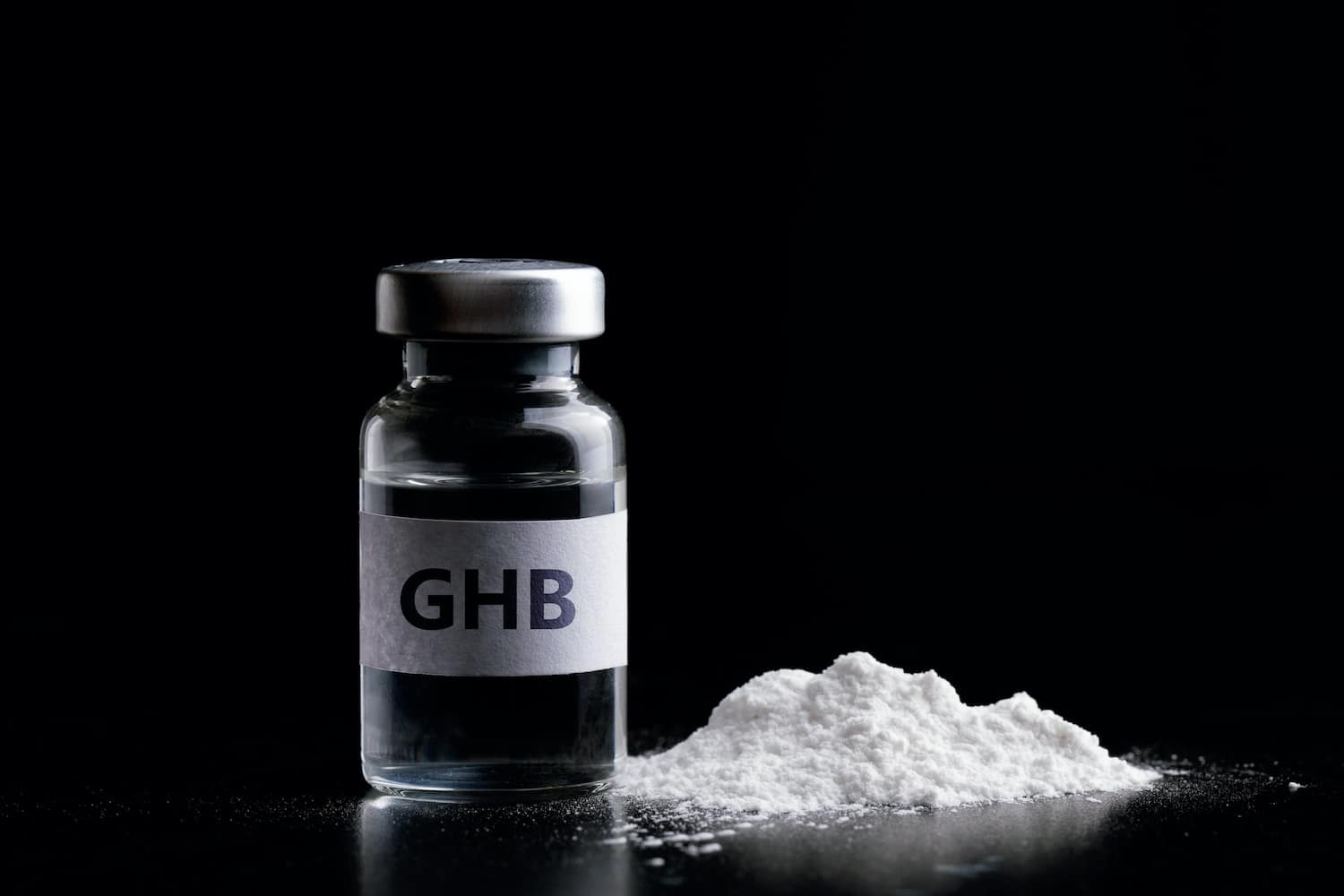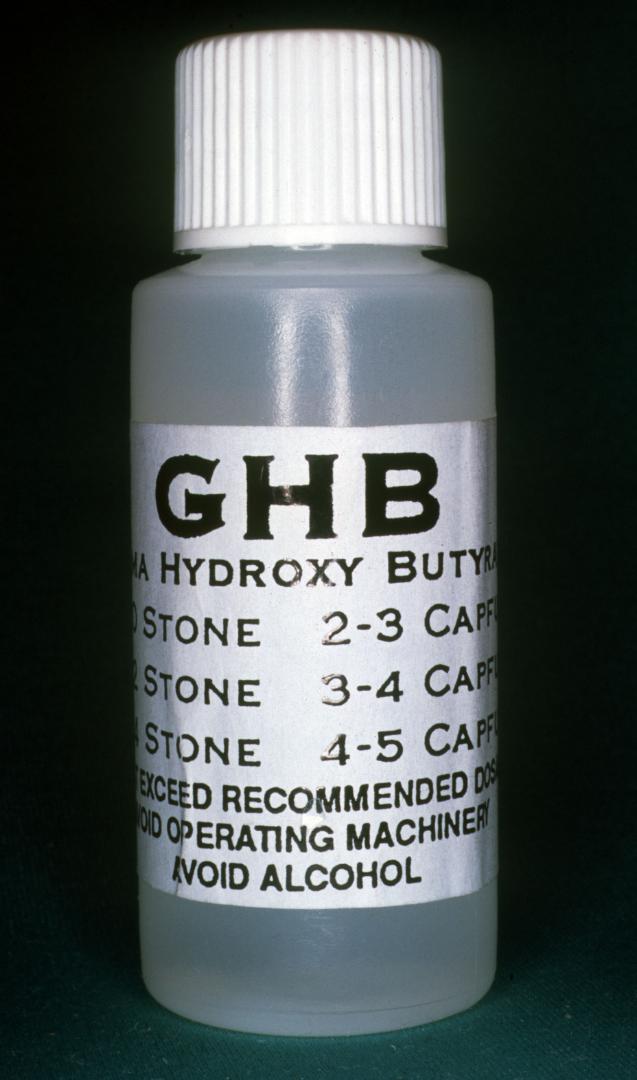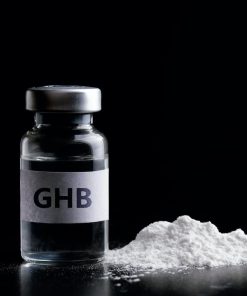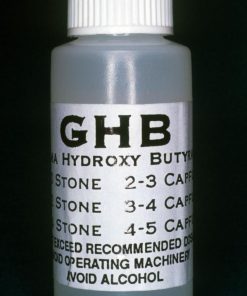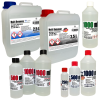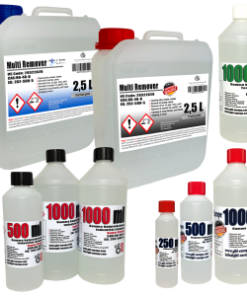GHB (Gamma HydroxyButyrate)
$275.00 – $1,799.99
What is hydroxybutyric acid used for?
BUY GHB ONLINE | BUY GAMMA HYDROXYBUTYRATE | How to Buy Supplements Online Safely | USA, Ukraine, and Russia Guide Using Bitcoin
Buy Gamma Hydroxybutyrate covered by credible lab test results
Best place to Buy GHB online or Gamma Hydroxybutyrate is a psychoactive drug prepared in the laboratory and is known to mimic the effect of GABA neurotransmitters. It is produced with the help of natural fermentation and is found in small quantities in some wines and beers. In the late 20th century, it was marketed as a dietary supplement that helped lose weight and aid recovery. However, human consumption was banned following the syndromes caused by trace impurities.
One can buy GHB to conduct research and analysis on the pharmacological action of this substance. We encourage people from scientific backgrounds to undertake groundbreaking studies on a wide range of chemicals we offer. Our GHB drug for sale is popularly known for its consistency, purity, and quality. Place an order today and get your package delivered discreetly. Buy GHB online
What is hydroxybutyric acid used for?
Effects of drug abuse with Buy GHB online
GHB is a newer drug of abuse that has gained popularity among bodybuilders and recreational users. It is a potent depressant that acts on the central nervous system and produces euphoric effects. Because of this, it can be even more lethal when combined with other drugs or alcohol. As per the FDA, there’s currently no medical use of this product, and they have issued a public warning given the rising cases of serious illnesses. Because of its low cost and ready availability, Gamma Hydroxybutyrate is a troublesome substance. Anyone can buy GHB online through illicit means, but if you are a researcher looking to understand the toxicology of this substance, we have a legitimate solution for you.
Manage GHB Dose
The major concern with clinical toxicology is acute intoxication caused by GHB abuse and the best way to manage it. There are no effective antidotes to reverse the effects of the overdose. Although the quantitative analysis of GHB in the blood is well documented, further studies may be required to conclude the reasons for intoxication.
The interpretation is trickier when dealing with specimens taken from dead bodies since higher concentrations are present in urine and blood without exposure to GHB. There are many challenges to substantiating your claims, and we help you achieve them by offering top-grade GHB at a price anyone can afford. By following the standard golden method for forensic purposes, you are guaranteed to get highly sensitive and accurate data. We wish you all the best!
Where to buy GHB online in USA, Russia, Ukraine
Buy GBH from trusted supplier Ketamine Clinic. Restricted substances are hard to obtain in most countries, and you may even have to face legal consequences for illicit purchases. Unlike other vendors, A1 Researchers is a licensed distributor of research chemicals. You can buy gamma-hydroxybutyrate online from our store without any paperwork. Customer satisfaction is the core objective of our organization, and we always try our best to deliver on our promises. We are not only a retailer but also an advisor to those looking for guidance. Our experts have in-depth experience in this field. 24/7 availability ensures you can get in touch with us at your convenience.
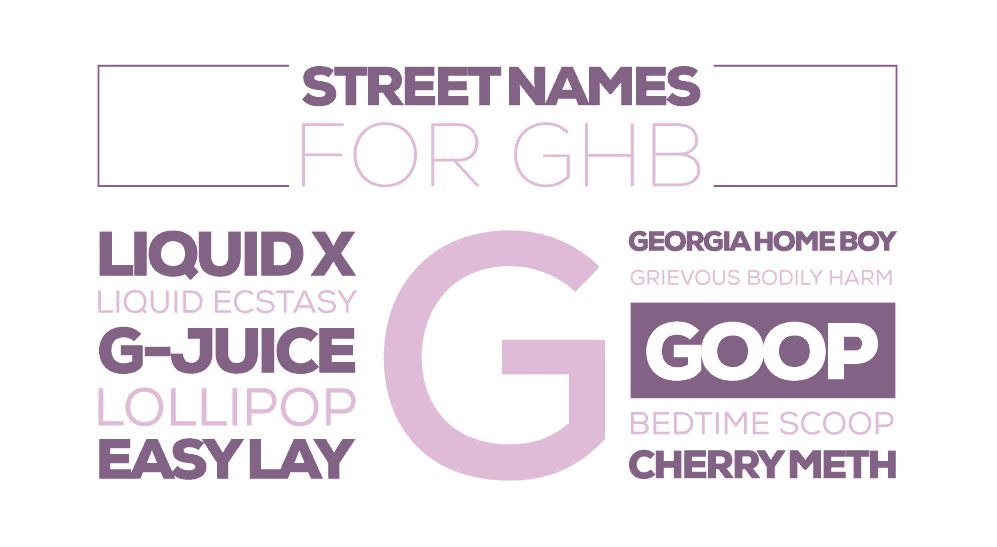
What is GHB?
GHB or Gamma Hydroxybutyrate (C4H8O3) is a central nervous system (CNS) depressant that is commonly referred to as a “club drug” or “date rape” drug. GHB is abused by teens and young adults at bars, parties, clubs, and “raves” (all-night dance parties), and is often placed in alcoholic beverages. Euphoria, increased sex drive, and tranquility are reported positive effects of GHB abuse. Negative effects may include sweating, loss of consciousness, nausea, hallucinations, amnesia, and coma, among other side effects.
Xyrem (sodium oxybate), a brand-name prescription drug was approved by the Food and Drug Administration (FDA) in 2002 for the treatment of narcolepsy, a sleep disorder that causes excessive sleepiness and recurring daytime sleep attacks. It is the sodium salt of gamma-hydroxybutyrate. Xyrem is a highly regulated drug in the U.S. It is a Schedule III controlled substance, and requires patient enrollment in a restricted access program.
GHB is also a naturally occurring metabolite of the inhibitory neurotransmitter gamma-aminobutyric acid (GABA) found in the brain. The naturally-occurring metabolite GHB is present in much lower concentrations in the brain than those levels found when the drug is abused. As a result of fermentation, natural GHB may also be found in small but insignificant quantities in some beers and wines.
Methods of GHB Abuse
GHB is available as an odorless, colorless drug that may be combined with alcohol and given to unsuspecting victims prior to sexual assaults. It may have a soapy or salty taste. Use for sexual assault has resulted in GHB being known as a “date rape” drug. Victims become incapacitated due to the sedative effects of GHB, and they are unable to resist sexual assault. GHB may also induce amnesia in its victim. Common user groups include high school and college students and rave party attendees who use GHB for its intoxicating effects.
GHB has also been postulated to have anabolic effects due to protein synthesis and has been used by bodybuilders for muscle building and reducing fat.
GHB is bought on the streets or over the Internet in liquid form or as a white powdered material for illicit use. It is taken orally and is frequently combined with alcohol. Much of the GHB found on the streets or over the Internet is produced in illegal labs. GHB may be adulterated with unknown contaminants that may worsen its toxicity. The production of GHB usually involves the use of lye or drain cleaner mixed with GBL, a chemical cousin of GHB and an industrial solvent often used to strip floors.
The sodium salt of GHB, the brand product Xyrem (sodium oxybate), is classified as a Schedule III drug by the DEA when prescribed and used legally in a patient-restricted-access program. Xyrem is not available at regular retail pharmacies. If Xyrem is trafficked as a recreational drug, its status converts to Schedule I and it becomes an illegal drug. Buy gamma-hydroxybutyric acid
Gamma-hydroxybutyrate for sale in both solid and liquid
Gamma Hydroxybutyrate (C4H8O3) is a central nervous system (CNS) depressant that is commonly referred to as a “club drug” or “date rape” drug. Gamma-hydroxybutyrate is abused by teens and young adults at bars, parties, clubs, and “raves” (all-night dance parties), and is often placed in alcoholic beverages. Euphoria increased sex drive, and tranquility are reported positive effects of Gamma-hydroxybutyrate abuse.1,2 Negative effects may include sweating, loss of consciousness (reported by 69 percent of users), nausea, hallucinations, amnesia, and coma, among other adverse effects.
Therapeutic use | gamma-hydroxybutyric acid
Anesthetic with a sedative quality. Gamma-hydroxybutyrate has been used as a premedication to surgery and more recently, it has been used in treatment for sleep disorders.
Buy GHB Online. gamma-Hydroxybutyric acid or γ-Hydroxybutyric acid, also known as 4-hydroxybutyric acid, is a naturally occurring neurotransmitter and a psychoactive drug. It is a precursor to GABA, glutamate, and glycine in certain brain areas. It acts on the GHB receptor and is a weak agonist at the GABAB receptor.
GHB (Gamma hydroxybutyrate) is an anesthetic with primarily sedating rather than painkilling properties. It is often sold as ‘liquid ecstasy’ because of its relaxant and euphoric effects, although it has no relationship to ecstasy.
GBL (Gamma butyrolactone) and 1,4-BD (1,4-butanediol) are chemicals that are closely related to GHB. Once GBL or 1,4-BD enter the body, they convert to GHB very quickly.
GHB, GBL, and 1,4-BD are clear, odorless, oily liquids that taste slightly salty. Users often swallow them mixed with water or other soft drinks. When intended for illicit use, GHB, GBL, and 1,4-BD are sold in small bottles or capsules. However, as solvents, GBL and 1,4-BD do have legitimate uses, for example in some paint strippers and stain removers.
Tab Title
Gamma-hydroxybutyrate (GHB) for narcolepsy in adults: an updated systematic review and meta-analysis
Abstract
Background: Narcolepsy is a chronic and debilitating sleep disorder characterized by cataplexy and excessive daytime sleeping. Gamma-hydroxybutyrate (GHB) has been widely used to treat narcolepsy, and new findings have been published in recent years.
Objective: A meta-analysis was conducted to assess the efficacy and tolerability of GHB treatment in adults with narcolepsy.
Methods: A systematic search of PubMed, Cochrane, Embase, Web of Science, and clinical-trials.gov from inception to June 2018 was performed. Change in daily diaries and polysomnographic data of narcoleptic patients were defined as the efficacy outcomes. The tolerability and acceptability outcomes were the rates of adverse events and dropping out for adverse effects or other reasons.
Results: Fifteen randomized controlled trials involving 2104 participants were identified. GHB was found to improve cataplexy attacks (P = 0.001), subjective daytime sleepiness (P < 0.0001), daytime sleep latency (P < 0.0001), inadvertent naps/sleep attacks (P < 0.00001), effective rates (Clinical Global Impression of change) (P < 0.00001), hypnagogic hallucinations (P = 0.004), sleep paralysis (P = 0.004), stage 1 sleep (P = 0.04), slow wave sleep (P = 0.003), REM sleep (P = 0.0006), sleep shifts (P = 0.005), nocturnal awakenings (P = 0.004), quality of nocturnal sleep (P < 0.00001), chin muscle activity, and quality of life, but had no effect on stage 2 sleep (P = 0.88). GHB was less well tolerated than placebo because of side effects that occurred in a dose-dependent fashion (RR = 6.08; 95% CI = 2.18 to 16.97; P = 0.0006).
Conclusions: GHB was effective in improving narcolepsy-cataplexy and related symptoms in adults but was less well tolerated than placebo because of dose-dependent side effects.
Gamma-hydroxybutyrate abuse: pharmacology and poisoning and withdrawal management
Gamma-hydroxybutyrate (GHB) is a central nervous system depressant that is primarily known for its recreational use and potential for abuse. However, it is also used clinically for the treatment of narcolepsy with cataplexy in adults, as well as an adjuvant therapy in managing alcohol withdrawal syndrome.
The main objective of this review is to provide an updated overview of:
-
GHB pharmacokinetics and pharmacodynamics
-
Features of acute poisoning
-
Clinical presentation and treatment of GHB withdrawal syndrome
Acute Poisoning
The most common signs and symptoms of acute GHB poisoning range from sleepiness to deep coma, and may include:
-
Bradycardia
-
Hypotension
-
Respiratory failure
Treatment is largely supportive, relying on continuous monitoring of vital signs.
Withdrawal Syndrome
GHB withdrawal shares several characteristics with alcohol withdrawal, making it difficult to distinguish—especially when toxicological testing is unavailable or negative.
There are currently no official detoxification protocols for GHB withdrawal. Treatment is typically based on:
-
Benzodiazepines as the first line
-
If ineffective, they may be combined with barbiturates or antipsychotics
Challenges in Detection and Monitoring
Information regarding the prevalence of GHB abuse and the distribution of its precursors and analogues remains limited. Therefore, prompt identification, especially in non-conventional biological matrices, is essential to better understand and manage the complexities associated with this substance
GHB Pharmacology and Toxicology: Acute Intoxication, Forensic Detection, and Withdrawal Treatment
Gamma-Hydroxybutyrate (GHB) is a powerful central nervous system depressant often encountered in forensic toxicology and emergency medicine across the USA, UK, Germany, and Europe. Both a therapeutic agent and a recreational drug of abuse, understanding the pharmacology, toxicology, detection methods, and withdrawal management of GHB is essential for healthcare professionals, forensic experts, and law enforcement agencies.
What is GHB and Its Medical Uses?
GHB, chemically known as γ-hydroxybutyrate, functions endogenously in the brain as a precursor and metabolite of gamma-aminobutyric acid (GABA), the primary inhibitory neurotransmitter. Its physiological concentrations are low, generally around 0.5–1.0 mg/L in tissues including the brain.
Pharmaceutically, GHB exists as sodium salt formulations such as Xyrem®, approved in several countries including the USA and Germany for treating narcolepsy-associated cataplexy. Additionally, Alcover® is used as an adjuvant medication to aid alcohol detoxification and withdrawal management.
However, illicit use of GHB and its precursors—γ-butyrolactone (GBL) and 1,4-butanediol (BD)—remains a global concern, especially in recreational settings and forensic investigations.
(Internal link: Learn more about Gamma Butyrolactone (GBL) and its role as a GHB precursor.)
Pharmacodynamics and Pharmacokinetics of GHB
GHB acts primarily on GABA-B receptors, producing sedative, analgesic, and hypnotic effects. Its rapid onset, usually within 20-40 minutes post-ingestion, is due to fast conversion of precursors GBL and BD into active GHB molecules (half-life ~1 minute for conversion).
The plasma elimination half-life is roughly 30-50 minutes, with urinary excretion of only 1-5% of the administered dose, creating a narrow window for forensic detection.
(Internal link: For a comparison of CNS depressants, explore our detailed article on Ketamine Treatment for Depression.)
Acute Intoxication and Toxic Effects
Recreational doses (~100 mg/L plasma) produce euphoria, relaxation, and disinhibition. At higher concentrations (≥ 500 mg/L), GHB can cause:
- Severe respiratory depression
- Cardiovascular collapse
- Coma and death
In forensic toxicology cases across Europe and North America, GHB intoxication is frequently implicated in drug-facilitated sexual assault and unexplained unconsciousness.
(Internal link: Understand more about ketamine vs esketamine—both potent CNS agents with dissociative effects.)
Forensic Detection Challenges
The endogenous presence of GHB and its rapid metabolism complicate detection in blood and urine samples. Forensic experts advise:
- Prompt sample collection, ideally within 3-10 hours of ingestion
- Careful differentiation of endogenous and exogenous GHB levels, using established cut-offs (>10 mg/L in urine)
These methods are crucial for investigations in the US, UK, and German forensic labs dealing with intoxication and overdose deaths.
(Internal link: Check our post on mental health awareness for broader context on substance abuse and mental wellness.)
Withdrawal Syndrome and Treatment Strategies
Chronic GHB users develop tolerance and dependence, leading to withdrawal symptoms upon abrupt cessation, including:
- Anxiety, agitation, and tremors
- Insomnia
- Seizures and hallucinations in severe cases
No formal treatment protocols exist, but benzodiazepines are the primary pharmacological intervention. Supportive care is vital during detox, and clinical guidelines vary between the US and Europe.
(Internal link: Discover insights on psychedelic therapy and withdrawal at psychedelic therapy overview.)
Legal Status and Regulatory Landscape
GHB is a controlled substance (Schedule I or III depending on jurisdiction), while its precursors GBL and BD remain less regulated, facilitating illicit manufacture and distribution.
- In the USA, ketamine and GHB are regulated substances, yet diversion from veterinary and medical sources persists.
- Germany and other European nations have tightened regulations on GBL and BD due to their conversion to GHB.
- Public health initiatives focus on harm reduction and awareness to combat recreational abuse.
(Internal link: Learn how to safely buy ketamine online for therapeutic purposes.)
Supportive Care in GHB Overdose Cases
Since there is no antidote for GHB intoxication, management focuses on:
- Monitoring airway, breathing, and circulation
- Preventing aspiration during vomiting
- Administering oxygen and intravenous fluids as needed
Emergency responders and healthcare professionals in the USA, UK, and Germany require training to promptly recognize and manage GHB poisoning.
(Internal link: Read about symptoms of eye damage related to other acute conditions for differential diagnosis.)
Summary and Recommendations
GHB is a complex drug with therapeutic value but significant abuse potential and forensic challenges. Effective clinical and forensic management depends on rapid detection, supportive care, and withdrawal management, particularly in regions like the US, UK, and Europe.
Ongoing research and regulatory efforts aim to mitigate risks while preserving legitimate medical use.
External references integrated naturally throughout the article:
- According to the Busardò & Jones study, GHB is rapidly metabolized, making timely forensic sampling critical.
- The FDA-approved Xyrem prescribing information highlights therapeutic uses of sodium oxybate.
- Forensic toxicologists face challenges outlined in this review on GHB detection.
- Benzodiazepines remain the frontline for GHB withdrawal management.
- The DEA scheduling document details controlled substance classification.
- Illicit GHB is often linked to drug-facilitated sexual assault cases.
- Studies show that GBL and BD convert rapidly to GHB, posing regulatory challenges (source).
- The European Monitoring Centre for Drugs and Drug Addiction provides surveillance data on GHB abuse.
- UK Home Office report includes GHB misuse statistics.
- Public health advice on safe ketamine use complements awareness about CNS depressants.
- The National Institute on Drug Abuse (NIDA) offers extensive data on GHB.
- Clinical protocols for CNS depressant overdose management from UpToDate provide treatment insights.
- Toxicology reviews from Elsevier’s ScienceDirect detail pharmacokinetics of CNS depressants.
- The World Health Organization’s Essential Medicines List includes sodium oxybate.
- Recent forensic case studies on GHB intoxication from Forensic Science International.
| GHB LIQUID | 1L, 2L, 3L, 4L, 5L, 10L |
|---|
Related products
CHEMICALS


